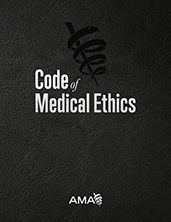The field of medical ethics is often ambiguous, esoteric and paradoxically arbitrary. Discussions about ethics during training revolve around case studies of patients without health care proxies and Beauchamp and Childress’s four accepted principles — and stop there. The ethical topics that are typical fodder for small-group discussions can seem tame and even distracting at a time where physicians are grappling with their roles in treating upticks in bias-motivated violence (“hate crime”), debating about the ethics of assisted death and protecting or performing women’s rights to have abortions.
In reality, the issues that we do face, lofty as they may seem, present themselves moment by moment, decision by decision. The AMA’s new Code of Medical Ethics book seeks to break down these moments and provide guidance for providers through issues that range from “6.1.2 Organ Donation After Cardiac Death” to “11.2.3.1 Restrict Covenants.” It is not a treatise but a modern manual for times of ethical uncertainty.
The book couches its input on bias-motivated violence in the broad section of “Preventing, Identifying, and Treating Violence and Abuse.” Despite its lack of specificity, I found it to be surprisingly forward-thinking. It puts the onus on individual physicians to detect violence and abuse, including cultural variations in response to abuse and be familiar with available community resources. It goes a step further by noting (in its matter-of-fact manner) that physicians are responsible for advocating for comprehensive training on this issue, providing leadership in raising awareness on the topic and supporting research to prevent abuse.
The AMA unequivocally vetoes the idea of physician assisted death, writing that, “physician-assisted suicide is fundamentally incompatible with the physician’s role as healer, would be difficult or impossible to control, and would pose serious social risks.” They demand that physicians respect patient autonomy (though it’s not clear to what extent) and provide adequate support and communication. There is no discussion of legality.
The book’s section on abortion may be its shortest. In its entirety: “The Principles of Medical Ethics of the AMA do not prohibit a physician from performing an abortion in accordance with good medical practice and under circumstances that do not violate the law.” This assessment of abortion would be laughable were it not one of the most contentious subjects in health care.
The Code of Medical Ethics is clear, navigable and — with some notable exceptions — far-reaching. It answers questions of responsibilities and boundaries, and it is not entirely toothless in its statements. This book is designed to provide granular detail on the AMA’s stances on all manner of ethical scenarios, and it serves its purpose reasonably well. Unfortunately, for most of us, it stops short of providing any new insight.



